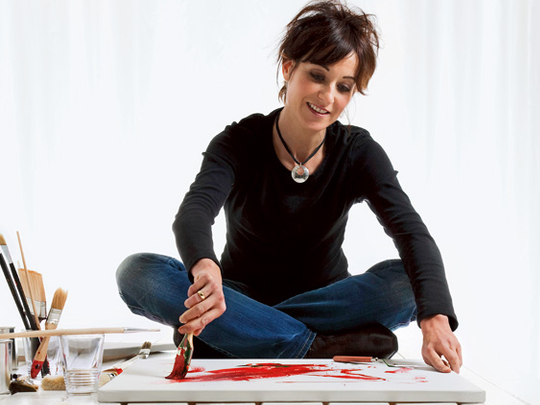
1. Identify your emotions
Write a list of different emotions, including happiness, anger, fear, love, hope, guilt and loneliness. Choose one emotion to work on first. Spend some time sitting with your eyes closed, thinking about the emotion and your own experiences with it. When you have the feeling clearly defined in your mind, open your eyes, choose a colour, and start creating. Some emotions might take longer to express than others - just let the process happen. When you have finished, sit back and look at your work. Don't criticise, or judge it. Just observe it and see how you have constructed that emotion. On the back, write the date, the emotion, a title for the piece, and a couple of sentences about what the emotion means to you. Work your way through the emotions until you have a full set. This may make you feel quite drained, so don't expect to be able to do it all in one go.
2. Be free
For art to be therapeutic, it needs to be free from self-criticism. Toma Gabor (www.tomagabor.com) is a UAE-based sculptor who has created art therapy workshops for adults, children and children with special needs. He says, "There are no universal recipes for individuals to relieve stress using art. The important factor in this process is for the individual not to think of it in terms of producing an aesthetic product... having expectations could lead to disappointment, which may be more stressful in the end."
3. Make it physical
Get creative with your art, by incorporating unusual materials in to the artwork. Gabor says, "You can relieve stress by using household materials, such as magazines, cardboard, photographs, plastic containers, Styrofoam, and other disposable items - anything is fair game." Try incorporating something which is representative of your emotional upset. For example, write it all down on paper, shred it and mix it in with the paint. Or, cut up photos and use indecipherable sections of them in your art.
4. Play with it
Berislava Grace (berislavaworld@yahoo.com.au) is an artist who has been practising art therapy around the world for more than a decade. She says, "Playing with colour is a good way of healing your emotions. Sit quietly, stay peaceful in the moment and listen to your body. Once you have spent some time with your thoughts, choose a colour and start to play with it on the canvas as children do. Welcome whatever comes out of you with love and understanding for yourself. As you play, your energy and the feeling of your work may shift and you may feel drawn to a different colour - either add to your first piece of art, or start a second."
5. Draw your future
Take three pieces of paper - one represents the past, one the present and one the future. Paint, draw, make a collage and create in any way that represents your life and feelings at these different times. Do them chronologically, starting with your past, then your present, finishing with your future, representing how you would like your life to develop. If you decide to do these as self-portraits, remember the aim is to be more expressive, rather than detailed and aesthetically correct. Once you have done them, keep your picture of your future somewhere you can see it every day.
6. Let it all go
As with most types of therapy, art therapy's main purpose is to help you get over an issue that is causing you grief, or stunting your life in some way. Salwa Zeidan is an artist, therapist and the owner of Salwa Zeidan Gallery (www.salwazeidangallery.com), which offers regular art therapy workshops. She says, "As we go through life, many of us get stuck in our personal growth because we suppress feelings of anger, or hurt, to avoid confrontations. However, the energy from those suppressed feelings doesn't just go away… it needs a release. Art therapy is an effective method for releasing our deeply held negative energy and transmuting it into something positive and beautiful. Don't be surprised if art therapy leads to a general sense of relief and overall better mental health. It's therapy, but with a completely different ingredient than what most people are used to."
7. Find the inner you
A good exercise for helping people express deeply submerged emotions is to encourage them to differentiate between the person they're perceived to be by others, and the person they feel they really are inside. Try this with two papier mâché masks - one representing how you're perceived, and one representing who you really are. If this is too messy for you, paint two portraits instead.
8. Deal with illness
For people suffering from long-term, or even terminal illness, art therapy can help overcome the frustration, anxiety and mental exhaustion which is experienced as a by-product of the illness. A study published in Science Daily found cancer patients reported feeling energised and also experienced a reduction in symptoms including pain, nausea, drowsiness and depression. A similar study found children suffering from asthma also enjoyed a better quality of life and less anxiety as a result of one session of art therapy per week, while another found art therapy significantly reduced depression and hopelessness in women struggling with fertility issues.
9. Uncover the issue
Art therapy can help bring repressed emotions to the surface. Dr Susan Hogan is the author of multiple books on art therapy and a professor in cultural studies and art therapy at the University of Derby, in the UK. She tells us, "We often make ourselves miserable through negative thought processes. Through art therapy, women can externalise their thoughts and feelings when, in the process of making images, recurring themes emerge. These themes could be feeling neglected, or abused, or patterns of destructive thinking, for example." Dr Hogan advises using intensive art therapy sessions to deal with these issues, and using simple affirmations, such as ‘My body is lovely' between art therapy sessions, to counteract destructive thinking habits.
10. Paint yourself strong
For people who struggle with self-esteem, art therapy can help boost their self-worth. Nicola Lee is an artist and regional manager for START, a non-profit body seeking to support children in need, and special needs children, with art activities. She says, "In our workshops, we use art to boost creativity and self-confidence and believe the skills learnt with us can be translated into all aspects of the children's lives.
"A popular medium to use is paint, as you can apply it in many different ways …Paint's versatile usability gives people the opportunity to work with colours without restrictions."











